February 14th, 2011 ~ by admin
The last week has been filled with new processor announcements, mainly for phones, but cameras as well. (yes they run some powerful processors now too).
TI is barely shipping products with its dual-core OMAP 4 applications processor and has already announced its successor, the OMAP 5. The OMAP 5 will be a 2GHz dual core ARM Cortex-A15 (the next ARM generation after the A9). It also includes a pair of ARM Cortex-M4 processor. the Cortex-M4 is a 150-300MHz microcontroller oriented processor. This will allow the OMAP 5 to run basic background tasks on the slower (lower power) cores while reserving the high power cores for tasks that actually need them, increasing battery life.
Broadcom continues its drive to enter the smart phone business with the BCM28150, a 1.1GHz dual core ARM Cortex-A9 compatible with Google Android. In December they released the BCM2157, a 500MHz dual core ARM11 processor for low-end smart phones
Samsung decided to rename the Orion processor (announced back in November) to the Exynos 4210. A bit of a mouthful compared to Orion.
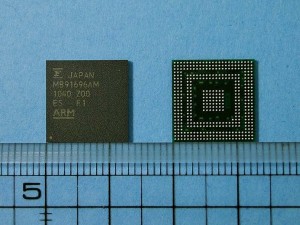
Fujitsu MB91696AM
Qualcomm showed off the APQ8060 in HP’s new TouchPad. This is a dual core version Snapdragon processor we have become very familiar with. Qualcomm has an architecture license from ARM so they are free to design their own cores without having to stick to ARMs own implementations (such as Cortex-A9 etc). This gives Qualcomm more flexibility to design in features they need, and tweak design more best efficiency.
Smart phones aren’t the only ones getting new processors. Digital cameras now require immense amount of processing power (especially to handle 1080p video recording. Fujitsu (yah, they still make a lot of processors) announced the Milbeaut MB91696AM. This is a dual core ARM processor with many other DSP functions capable of handling 14Mpixel shooting at 8fps, as well as full HD video.
November 14th, 2010 ~ by admin
Current smartphones have an impressive amount of processing power, and its getting better yet. Samsung’s new Orion chip has now been spotted running in the wild. This is one of the first of the next generation of mobile Application Processors.
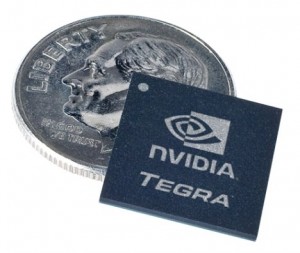
Nvidia Tegra
In 2008 a smart phone would have a ARM11 class processor running at around 500MHz. The original iPhone, and the iPhone 3G used one made by Samsung running at 412MHz. The first Android phone (the Google G1/HTC Dream) used a 528MHz Qualcomm MSM7201A ARM11 processor. The original Nvidia Tegra CPUs also fall into this class. We’ll consider this the first generation of the TRUE smart phones as before the iPhone, smart phones were of limited use, and rarely had things likely fully working internet browsing etc.
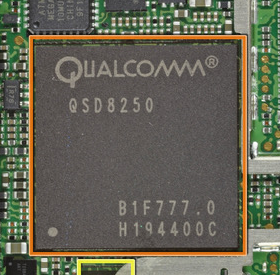
Qualcomm QSD8250 Snapdragon
The second generation of smart phones significantly increased in processing power. These are the phones that we use today. The majority of these run on some version of the ARM Cortex-A8 processor. These processors are single core 600MHz-1.3GHz devices. Perhaps the best known are the Apple A4 (Samsung Hummingbird), the Qualcomm Snapdragon (really a custom ARM core called the Scorpion similar to the Cortex-A8 crossed with a Cortex-A9), and the TI OMAP3 series. Second generation Application Processors also have brought some pretty powerful graphics to phones. These are integrated onto the same die as the Cortex-A8 and usually are PowerVR (Apple/Samsung and TI), Adreno (Qualcomm from ATI), or Mali (ARMs own GPU) based.
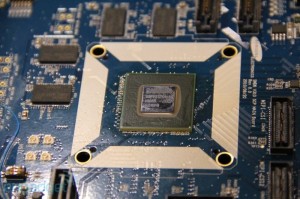
Samsung Orion ARM Cortex-A9 Dev Board
The smart phones of 2011 will begin using the third generation of Application Processors. These are defined by being based on the ARM Cortex-A9, a faster and more efficient ARM core, as well as typically being a dual core (or better) device. The TI OMAP4 series fits this description. Qualcomm will continue with the Snapdragon line, but bring it to a dual-core 1.5GHz chip. Apple is an unknown, but will likely up the speed of the A4, or add a core to it. Samsung;’s Orion is a dual-core 1GHz A9 with a quad core Mali GPU. It also packs 32KB of L1 cache per core and a full 1MB of L2 cache. Nvidia has the Tegra 250 already, which powers a handful of devices such as the Zune HD. These processors will handily run full 1080p video, as well as drive external displays. Your phone will soon be able to play movies on your TV.
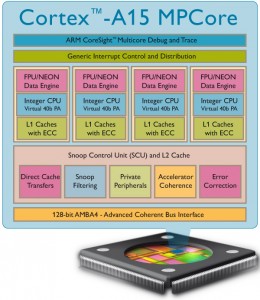
ARM Cortex-A15 Eagle
What will the future bring? ARM Cortex-A15, the Eagle, is a 2.5GHz quad core. Hopefully it can run without depleting our batteries in an hour.






